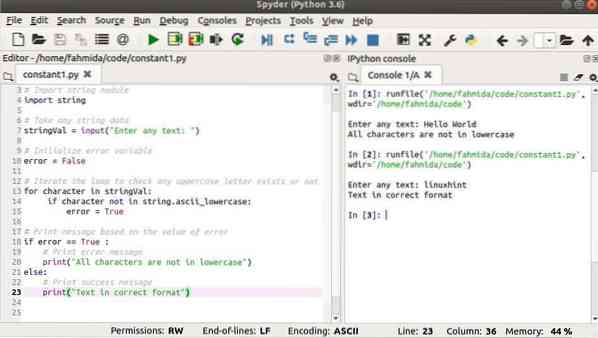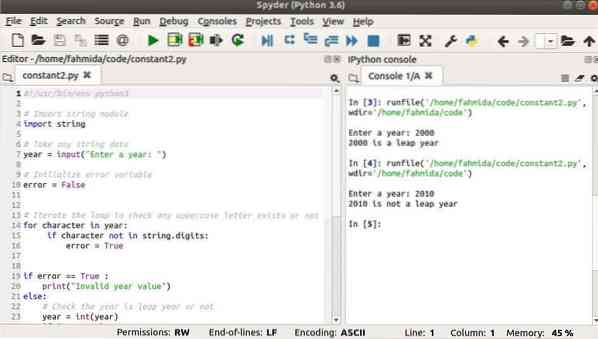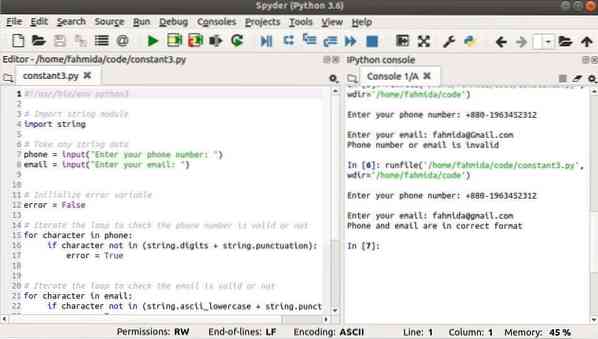String Constants in Python
The string module of python contains nine string constants. The values of these string constants are described in the table below.
| Constant Name | Value |
| ascii_lowercase | 'abcdefghijklmnopqrstuvwxyz' |
| ascii_uppercase | 'ABCDEFGHIJKLMNOPQRSTUVWXYZ' |
| ascii_letters | 'ABCDEFGHIJKLMNOPQRSTUVWXYZabcdefghijklmnopqrstuvwxyz' |
| digits | '0123456789' |
| hexdigits | '0123456789abcdefABCDEF' |
| octdigits | '01234567' |
| punctuation | !”#$%&'()*+,-./:;<=>[email protected][\]^_'|~ |
| whitespace | Includes the characters space, tab, linefeed, return, formfeed, and vertical tab |
| printable | Includes the values of digits, ascii_letters, punctuation, and whitespace |
These built-in string constants are used for validating data. The next section of this article covers the uses of some of the string constants mentioned above.
Example 1: Use of ascii_lowercase Constant
The following script will take any string data from the user and store it in the variable stringVal. The error variable is set initially to False. If any uppercase letter exists in the stringVal variable, then the error variable will be set to True. After checking all characters of stringVal, if the value of error remains False, then a success message will be printed. Otherwise, an error message will be printed.
#!/usr/bin/env python3# Import string module
import string
# Take any string data
stringVal = input("Enter any text: ")
# Inilialize error variable
error = False
# Iterate the loop to check any uppercase letter exists or not
for character in stringVal:
if character not in string.ascii_lowercase:
error = True
# Print message based on the value of error
if error == True :
# Print error message
print("All characters are not in lowercase")
else:
# Print success message
print("Text in correct format")
Output
The script is executed twice. The first input value is invalid, and the second input value is valid, as seen in the image below:

Example 2: Use of string.digits Constant
The following script checks whether the input text contains all number of characters by using the string.digits constant, as in the previous example. If the input value is valid, then the string value will be converted into an integer by using the int() method. Next, it will check whether the input value is a leap year.
# Import string moduleimport string
# Take any string data
year = input("Enter a year: ")
# Inilialize error variable
error = False
# Iterate the loop to check any uppercase letter exists or not
for character in year:
if character not in string.digits:
error = True
if error == True :
print("Invalid year value")
else:
# Check the year is leap year or not
year = int(year)
if (year % 4) == 0:
if (year % 100) == 0:
if (year % 400) == 0:
leapYear = True
else:
leapYear = False
else:
leapYear = True
else:
leapYear = False
if leapYear == True:
print("%d is a leap year" %year)
else:
print("%d is not a leap year" %year)
Output
The script is executed twice. 2000 is taken as the first input and is a leap year, and 2010 is taken as the second input and is not a leap year, as seem in the image below:

Example 3: Use of Multiple String Constants
The following script shows use of the string.digits and string.punctuation constants for the first input text and the string.ascii_lowercase and string.punctuation constants for the second input. The first input will take any phone number as the input, which can contain digits, the '+' symbol, and the '-' symbol. The first input will take any email address as the input, which can contain any small letters, the '@' symbol, and the '.' symbol. If the value of the error variable remains False after checking both input texts, then it will print a success message. Otherwise, it will print the error message.
#!/usr/bin/env python3# Import string module
import string
# Take any string data
phone = input("Enter your phone number: ")
email = input("Enter your email: ")
# Inilialize error variable
error = False
# Iterate the loop to check the phone number is valid or not
for character in phone:
if character not in (string.digits + string.punctuation):
error = True
# Iterate the loop to check the email is valid or not
for character in email:
if character not in (string.ascii_lowercase + string.punctuation):
error = True
# Print message based on the value of error
if error == True :
print("Phone number or email is invalid")
else:
print("Phone and email are in correct format")
Output
The script is executed twice. A valid phone and an invalid email address are given in the first execution and a valid phone and a valid email address are given in the second execution, as seen in the image below:

Conclusion
The uses of the three main built-in string constants of Python were explained in this article. Hopefully, reading this article should help Python users better understand how to use string constants in Python.
 Phenquestions
Phenquestions


